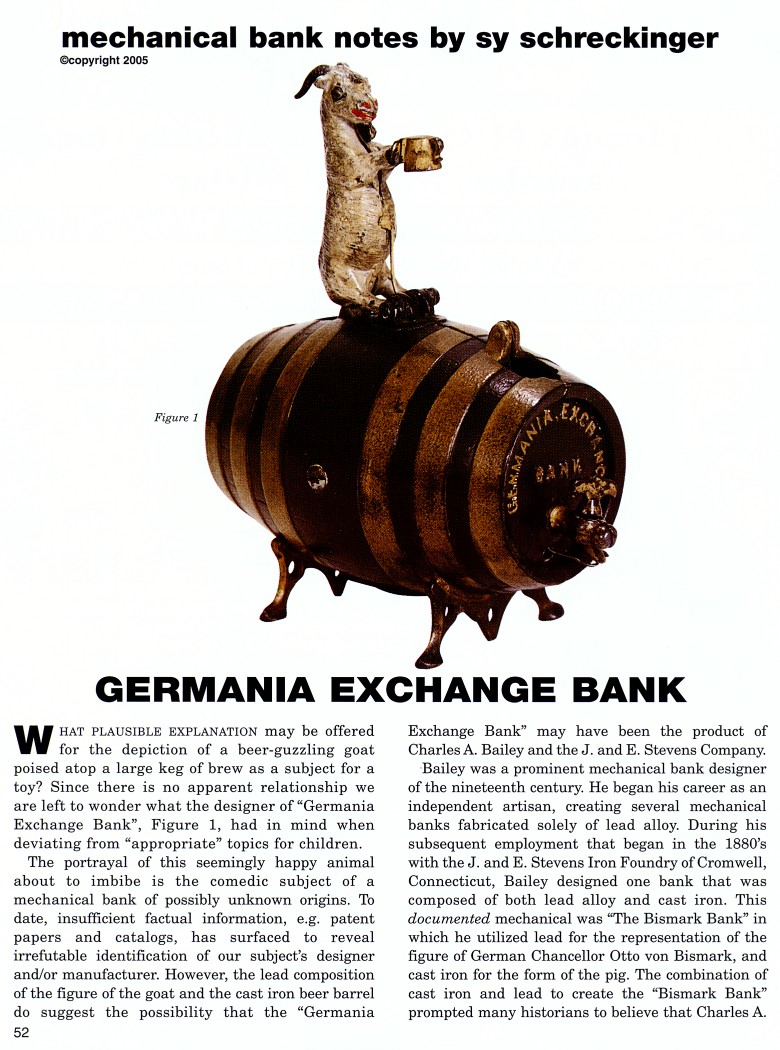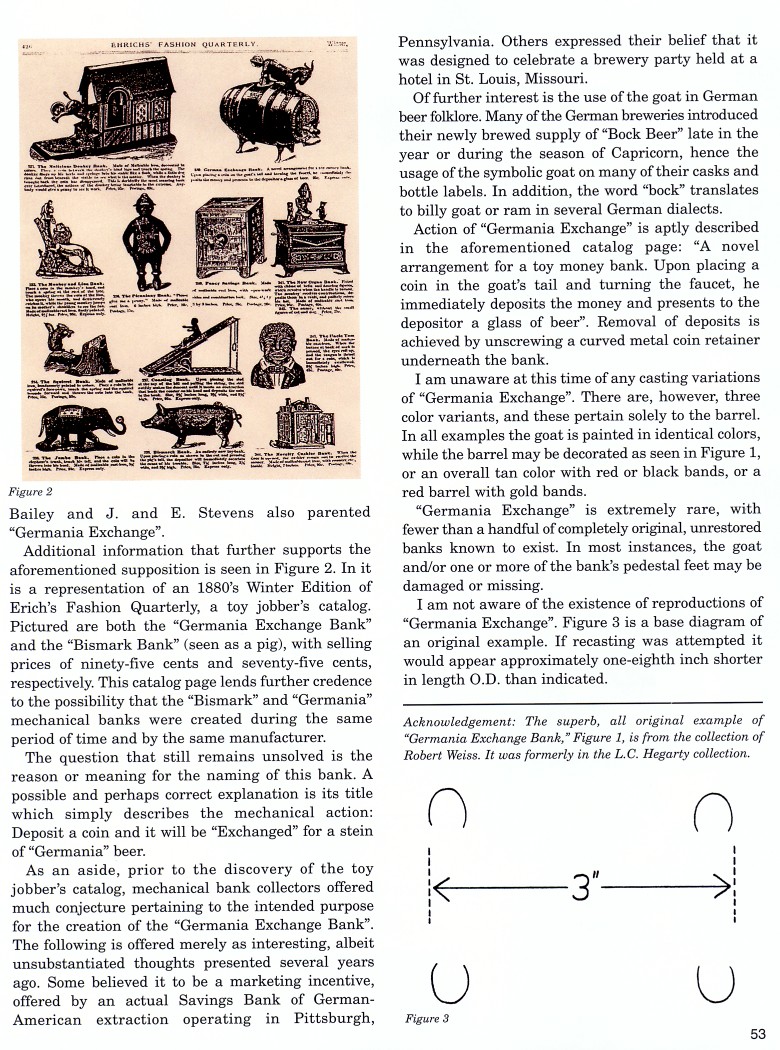|
Germania Exchange Bank
by Sy Schreckinger – ANTIQUE TOY WORLD Magazine – May, 2005
What pleasurable explanation may be offered for the depiction of a
beer-guzzling goat poised atop a large keg of brew as a subject for a toy?
Since there is no apparent relationship we are left to wonder what the
designer of "Germania Exchange Bank", Figure 1, had in mind when deviating
from "appropriate" topics for children.
The portrayal of this seemingly happy animal about to imbibe is the
comedic subject of a mechanical bank of possibly unknown origins. To date,
insufficient factual information, e.g. patent papers and catalogs, has
surfaced to reveal irrefutable identification of our subject's designer
and/or manufacturer. However, the lead composition of the figure of the
goat and the cast iron beer barrel do suggest the possibility that the "Germania
Exchange Bank" may have been the product of Charles A. Bailey and the J.
and E. Stevens Company.
Bailey was a prominent mechanical bank designer of the nineteenth
century. He began his career as an independent artisan, creating several
mechanical banks fabricated solely of lead alloy. During his subsequent
employment that began in the 1880's with the J. and E. Stevens Iron
Foundry of Cromwell, Connecticut, Bailey designed one bank that was
composed of both lead alloy and cast iron. This documented mechanical was
"The Bismark Bank" in which he utilized lead for the representation of the
figure of German Chancellor Otto von Bismark, and cast iron for the form
of the pig. The combination of cast iron and lead to create the "Bismark
Bank" prompted many historians to believe that Charles A. Bailey and J.
and E. Stevens also parented "Germania Exchange".
Additional information that further supports the aforementioned
supposition is seen in Figure 2. In it is a representation of an 1880's
Winter Edition of Erich's Fashion Quarterly, a toy jobber's catalog.
Pictured are both the "Germania Exchange Bank" and the "Bismark Bank"
(seen as a pig), with selling prices of ninety-five cents and seventy-five
cents, respectively. This catalog page lends further credence to the
possibility that the "Bismark" and "Germania" mechanical banks were
created during the same period of time and by the same manufacturer.
The question that still remains unsolved is the reason or meaning for
the naming of this bank. A possible and perhaps correct explanation is its
title which simply describes the mechanical action: Deposit a coin and it
will be "Exchanged" for a stein of "Germania" beer.
As an aside, prior to the discovery of the toy jobber's catalog,
mechanical bank collectors offered much conjecture pertaining to the
intended purpose for the creation of the "Germania Exchange Bank". The
following is offered merely as interesting, albeit unsubstantiated
thoughts presented several years ago. Some believed it to be a marketing
incentive, offered by an actual Savings Bank of German-American
extraction operating in Pittsburgh, Pennsylvania. Others expressed their
belief that it was designed to celebrate a brewery party held at a hotel
in St. Louis, Missouri.
Of further interest is the use of the goat in German beer folklore.
Many of the German breweries introduced their newly brewed supply of "Bock
Beer" late in the year or during the season of Capricorn, hence the usage
of the symbolic goat on many of their casks and bottle labels. In
addition, the word "bock" translates to billy goat or ram in several
German dialects.
Action of "Germania Exchange" is aptly described in the
aforementioned catalog page: "A novel arrangement for a toy money bank.
Upon placing a coin in the goat's tail and turning the faucet, he
immediately deposits the money and presents to the depositor a glass of
beer". Removal of deposits is achieved by unscrewing a curved metal coin
retainer underneath the bank.
I am unaware at this time of any casting variations of "Germania
Exchange". There are, however, three color variants, and these pertain
solely to the barrel. In all examples the goat is painted in identical
colors, while the barrel may be decorated as seen in Figure 1, or an
overall tan color with red or black bands, or a red barrel with gold
bands.
"Germania Exchange" is extremely rare, with fewer than a handful of
completely original, unrestored banks known to exist. In most instances,
the goat and/or one or more of the bank's pedestal feet may be damaged or
missing.
I am not aware of the existence of reproductions of "Germania
Exchange". Figure 3 is a base diagram of an original example. If recasting
was attempted it would appear approximately one-eighth inch shorter in
length O.D. than indicated.
Acknowledgement: The superb, all original example of "Germania
Exchange Bank," Figure 1, is from the collection of Robert Weiss. It was
formerly in the L.C. Hegarty collection.
|


